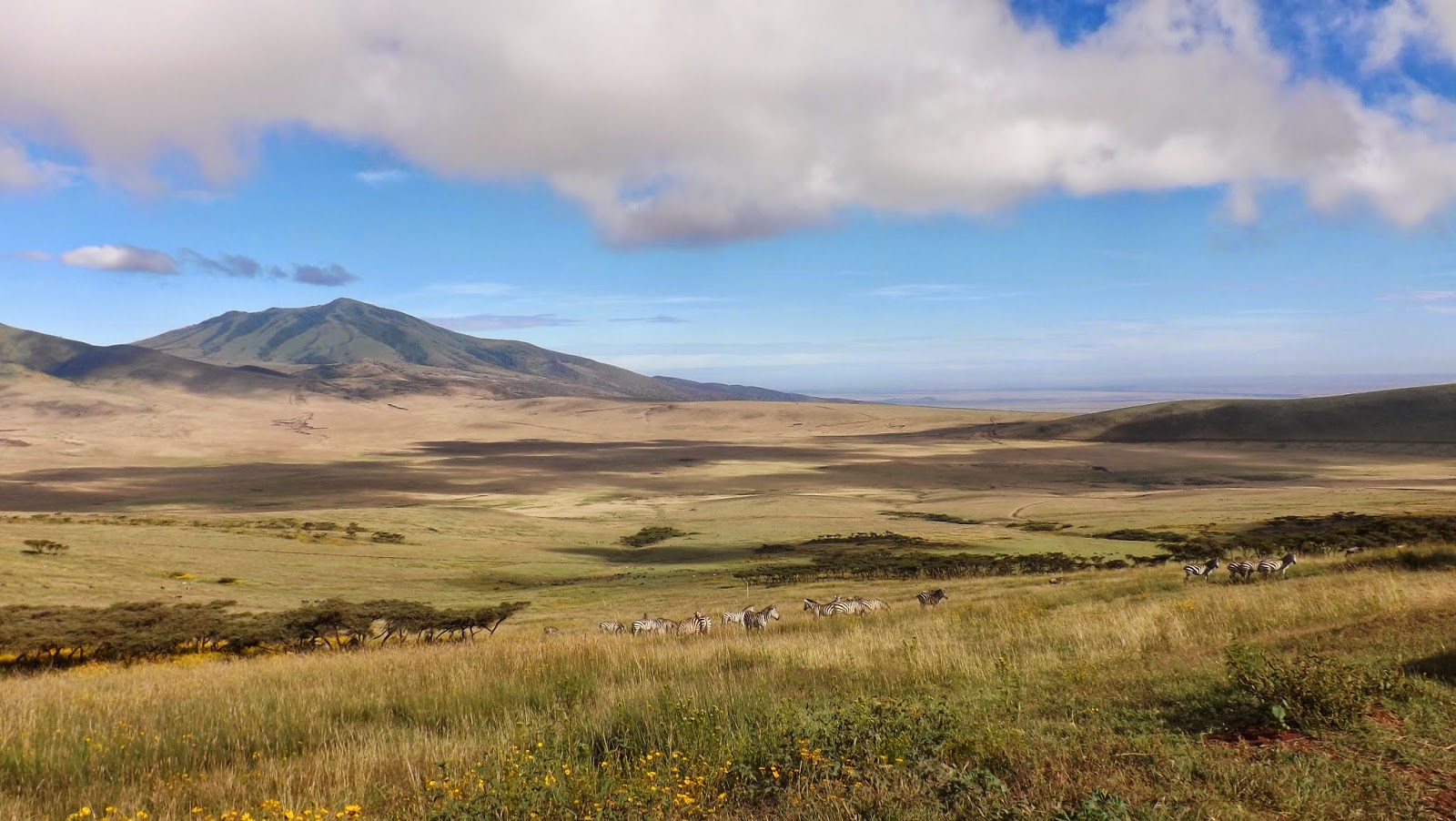
Our departure coincided with a group of Masai herdsmen moving their cattle down into the crater...
...they made a lively scene, the many belled cows tinkling as they walked down the rough path.
We descended the northern slopes of the crater leaving the cool mountain environment for the heat of the plains. These grasslands were shared with wild game and Masai cattle. We spotted herds of wildebeest, zebra and the occasional giraffe.
We passed more Masai herders and a number of traditional Masai compounds; they keep cattle on the better grass of the upper crater slopes, goats on the coarser dry flats.
This young Masai boy raced to the roadside to gesture to us to throw him something to eat. With no food to offer, Susan remembered that she had brought some small items to give to children. We tossed him a small rubber ball. Later, we wondered if he would recognize it as a plaything, or grasp our concept of play. We hoped he didn't try to eat it, or curse us for giving him something of little use.

We turned off the main road to Serengeti National Park to detour to Olduvai Gorge, encountering this jackal scurrying across the rather barren, dry plain. He didn't bother to sniff the remains of what was likely once a wildebeest.
My first career fantasy, role played as an eleven year-old, was to be a paleontologist (only I didn't know that was what a fossil hunter was called). I asked for a rock hammer for my birthday present...and spent many a happy Saturday hiking the sandstone gullies near home, looking for specimens.
So it turns out the museum is a little funky, the exhibits low tech and fading from the day they were produced 40 or more years ago. But there was some really interesting stuff like fossils of animals who frequented the area around Oldupai 1 to 1.5 million years ago. To get a sense of the size of the antelope, its horns have a span of five feet. Below and to the left of the antelope, is the pre-cursor to the giraffe, which is about 50% larger than a modern giraffe.
And never mind about the condition or simplicity of the museum. Oldupai Gorge is sacred ground to anyone with an interest in the discovery of scientific evidence revealing the history of human origins. This is the site where Mary Leakey discovered the skull (the mockup in the lower left) of Zinjanthropus boisei in 1959 -- the first hominid remains that would be accurately dated at 1.8 million years old. It was a profound discovery, providing evidence that human precursors were around more than 3 times earlier than any previous fossils indicated. It was big news back in the 1960s and made a big impression on a certain 11 year old.
Thanks to the discovery of Zinjanthropus boisei, Mary and Louis Leakey put paleoanthropology and Oldupai Gorge on the map. With their notoriety came sufficient funding to fully excavate many sites within the Gorge as well as other sites within Tanzania and Kenya.
Another of Mary Leakey's major finds is portrayed above. The exhibit shows the cast of footprints from three hominids made in fresh volcanic ash 3.7 million years ago . Discovered at a nearby site, Laetoli, the tracks were preserved when they hardened like concrete subsequently covered with more ash. When discovered in the late 1970s, the Laetoli tracks were the oldest evidence of hominid bipedalism and make a joke out of the so-called tracks of humans walking with dinosaurs at a certain amusement park.
The Leakeys' many discoveries, faithfully reported by their sponsors at the National Geographic Society, sparked interest among paleontologists around the world and caught the attention of many college students unsure of what to major in; spawning even more discoveries of hominid remains throughout Southern and Eastern Africa.
It was a real thrill to stand and gaze into the Gorge to see where the Leakey's spent much of their working years rigorously excavating and cataloging the most minute details of each dig.
Double click the panoramic picture above (or any picture in my Blog posts) to see an enlarged version of the image.
Oldupai was originally the site of a large lake, where hominid groups lived along its banks. The climate changed, the lake dried up, the area was uplifted and fractured by a series of faults and cut by seasonal streams creating the terrain you see today. Right down there is where Mary Leakey made her first major discovery.
The gray strata at the bottom of the gorge is an accumulation of volcanic ash laid down between 1.9 and 1.5 million years ago. This layer produced most of the Leakey's major finds and continues to be worked at various locations throughout the Gorge. I was told that most excavation sites are located by simply walking the gorge looking at areas recently eroded by summer rains. Today, 35 sites within Oldupai are actively being excavated by teams from Universities around the Globe.
As we left the edge of the gorge to resume our drive, I couldn't help thinking about early man, climbing down out of the trees...to one day climb into the safety of their Toyotas.












No comments:
Post a Comment